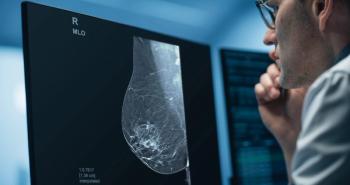
Fewer Screening Mammography Recalls Associated with More Interval Breast Cancers
More interval breast cancers detected when screening mammography recall rates are low.
Lower screening mammography recall rates are associated with higher rates of interval cancers, according to a study published in the journal Radiology.
Researchers from the United States and the United Kingdom sought to determine the relationship between recall levels following screening mammography and interval cancers among women aged 50 to 70 years. Data were drawn from a 36-month period with a three-year follow-up.
The researchers retrospectively analyzed 5,126,689 screening episodes and found an average recall to assessment rate (RAR) of 4.56 percent (1.64 percent-8.42 percent), cancer detection rate of 8.1 per 1,000 women screened and interval cancer rate (ICR) of 3.1 per 1,000 women screened.
Overall, a significant negative association was found between RAR and ICR, with approximately one fewer interval cancer for every additional 80 to 84 recalls. Women aged 50 to 54 years, 60 to 64 years, and 65 to 69 years had similar negative correlations, incident screens, and prevalent screens. However, no significant relationship was found among women aged 55 to 59 years.
“Recall rate had more of an impact on interval cancer in patients who are older,” Elizabeth S. Burnside, MD, MPH, from the University of Wisconsin School of Medicine and Public Health in Madison, Wisc., said in a release. “The lower number of recalls required per interval cancer avoided in older women and incident screens as compared to younger women and prevalent screens, respectively, demonstrates a slightly different ‘value’ in terms of the trade-off between recall rate and interval cancers.”
The researchers noted that additional research will help determine a specific minimum threshold for recall rate and assess the impact of digital mammography on the relationship between recall rate and interval cancers.
“A big-picture lesson in our study is the power of rigorous quality assurance infrastructure to help breast cancer screening programs learn from actual practice and use that information to make informed programmatic decisions for the future,” Burnside added. “This study documents the benefit of carefully tracking mammography use and outcomes as achieved in the [U.K. National Health Service Breast Screening Program].”
Newsletter
Stay at the forefront of radiology with the Diagnostic Imaging newsletter, delivering the latest news, clinical insights, and imaging advancements for today’s radiologists.




























